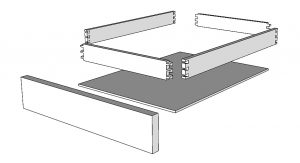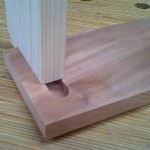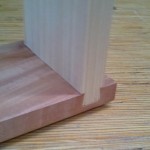We may receive a commission when you use our affiliate links. However, this does not impact our recommendations.
 Before I jump onto my soapbox to spout off, I’ll share a bit more about drawers for my upcoming workbench. I plan to have two stacks, each with five drawers. Sizes range from a small 2-3/16″-deep drawer to the deepest, bottom drawer at 3-3/8″ deep. My SketchUp drawing shows an exploded drawer, including how the parts assemble – I have dovetails drawn, but I can just about guarantee that I will not dovetail these drawers.
Before I jump onto my soapbox to spout off, I’ll share a bit more about drawers for my upcoming workbench. I plan to have two stacks, each with five drawers. Sizes range from a small 2-3/16″-deep drawer to the deepest, bottom drawer at 3-3/8″ deep. My SketchUp drawing shows an exploded drawer, including how the parts assemble – I have dovetails drawn, but I can just about guarantee that I will not dovetail these drawers.
In the comments on my last post, Narayan suggested making my drawers accessible from both sides of the bench. That’s a great idea, thank you. And due to the fact that my bench may sit away from any walls, this idea moved to the front of my plans. (This is why I ask for your ideas.)
 OK. I am now up on my soapbox to preach. As I searched for information on sliding dovetails for my drawer fronts – an idea that has now been trashed – I discovered that I have been wrong when I talked about sliding dovetails. This joint seems to now be known as “French” dovetails.
OK. I am now up on my soapbox to preach. As I searched for information on sliding dovetails for my drawer fronts – an idea that has now been trashed – I discovered that I have been wrong when I talked about sliding dovetails. This joint seems to now be known as “French” dovetails.
I’ve been building furniture for more than 30 years and I just discovered the term French dovetails. Who the hell renamed this joint? It certainly could not have been in the woodworking community – the folks that build furniture and use proper terminology – or I would have heard something.  No, I discovered that this was a term adopted by furniture stores to differentiate between a true dovetail (what these stores call English dovetails), and a less-impressive sliding dovetail. I can only assume that furniture stores did so because customers have learned that dovetailed drawers equate to better quality. And it’s easy to say English or French dovetails without really knowing the difference.
No, I discovered that this was a term adopted by furniture stores to differentiate between a true dovetail (what these stores call English dovetails), and a less-impressive sliding dovetail. I can only assume that furniture stores did so because customers have learned that dovetailed drawers equate to better quality. And it’s easy to say English or French dovetails without really knowing the difference.
If I were of French ancestry, I’d be hacked off. If you know of other woodworking terms that have been manipulated and twisted by retail store marketing, please let me know.
Build Something Great!
— Glen D. Huey
Looking for more information on dovetails? Pick-up a copy of Chuck Bender’s DVD, “Dovetailing Apprenticeship” or learn my router setup and process for easy sliding dovetails in this download-ready article, click here.
Here are some supplies and tools we find essential in our everyday work around the shop. We may receive a commission from sales referred by our links; however, we have carefully selected these products for their usefulness and quality.









French Dovetails? Sliding Dovetails? I don’t know know about the “french” dovetail — what I know about “sliding dovetails is that “All Dovetails Slide.” I know I am tilting at windmills, but the proper name for what is commonly called a “sliding dovetail” is: “housed dovetail.” A tapered one of the same is “housed tapered dovetail.” Back in school Lance was adamant about terminology.
Call a half lap dovetail a “half blind” dovetail and you would hear pretty quickly that “no dovetails can see.” No smile, no joke, but true.
As “Full blind” is properly a secret or secret miter dovetail.
And lest we forget, cabinets don’t have sides, they have ends.
The list goes on. LIke I said, I know I am tilting at windmills, but mis-use of terminology makes me mad.
Don’t even start on the mis-use of “dock” in the marine world. Most use the verb correctly, but the noun has lost its meaning to the point of my dismay.
Enjoy your french.
Bob
Could name this have any relationship to “French Cleat”?
Not a soap box, this pisses me off too. Another example is the decimal notation in Europe. In the scientific as well as decimal notation, whole number have always been separated in the thousands by a comma and the decimal fractions by a period. Well some idiot decided or got his nomenclature confused and now they are separating thousands with a period and fractions with a comma. I don’t know who or whom were the idiots who decided to change this and why the rest of the sheep followed this moronic notation, but it really pisses me off to no end. As they saying goes, if it ain’t broke don’t fix it!
My sense is that “French-dovetail” is a typical commentary on anything French that, without fail, occurs in British humor. In the late 1960’s I worked for Gillette, Boston as an industrial engineer designing assembly lines with many wood fixtures. They were quick set-up and take down affairs because of their seasonal nature. Gillette had full in-house shop facilities including carpenters, mill wrights, tin smiths, and machinists, fully staffed and very capable. While watching my first installation, I was introduced to the “Philadelphia-screwdriver!” It was a graphic and grand demonstration, driving screws with a hammer! Wonder if Philadelphia has a “Boston-screwdriver?” They most certainly came up with the “Yankee” screwdriver. Any humor there?
On my bench I can access the drawers from both sides as well. I copied the idea from Robert Whitley, a Pennsylvania studio furniture maker who also does killer reproductions. Anyway. His as well as mine also have lids [dust covers] on some of the drawers as they can be used as a series of supports for wide boards held in the face vise [like board jacks]. Mine are machine dovetailed and peruse the NK style of drawer construction. A bit of a pain to produce as they are almost “stick” built but they work fabulously.
always,
the dark one…
The first time I saw the term French dovetails was in Moser’s 2nd edition of “How to Build Shaker Furniture.” I spent a ton of time trying to figure out the difference between sliding dovetails and the beret-wearing, Gauloise-smoking variety. Like an idiot.
A nomenclature data point – a buddy who sells furniture was the first time I ever heard French Dovetail. I asked him what the heck he was talking about and when he described it I realized he was talking about a standard sliding dovetail. Also, what we think of as normal dovetails, apparently in the furniture industry they are referred to as “English dovetails.”
Glen, I just emails a picture of some “dovetails”. Although I’m not sure what they’re called, they are certainly a marketing attempt to capitalize on the traditional dovetail look.
Also, I built a bench with drawers that pass thru both sides. I dovetailed them and then cut a 3/4″ groove 1/2″ deep down the middle of each side with a dado stack. They work great.
Cheers,
Mark
So just why did you trash the idea of using the sliding (er…excusee moi, French) dovetails? Especially tapered ones. Too difficult to line up the front and the….front?
if you use sliding dovetails (of whatever heritage) on “double-sided” drawers, how do you get the bottom in unless you nail it on from the bottom?
if you want to save some time and not fuss with (proper) dovetails I would suggest either box joints (assuming you have a jig already handy) or some form of rabet joint that you can reinforce with dowels or something similar.
or you just bite the bullet and start fiddling with the pigeon’s behind… the right (English) way.
Cheers